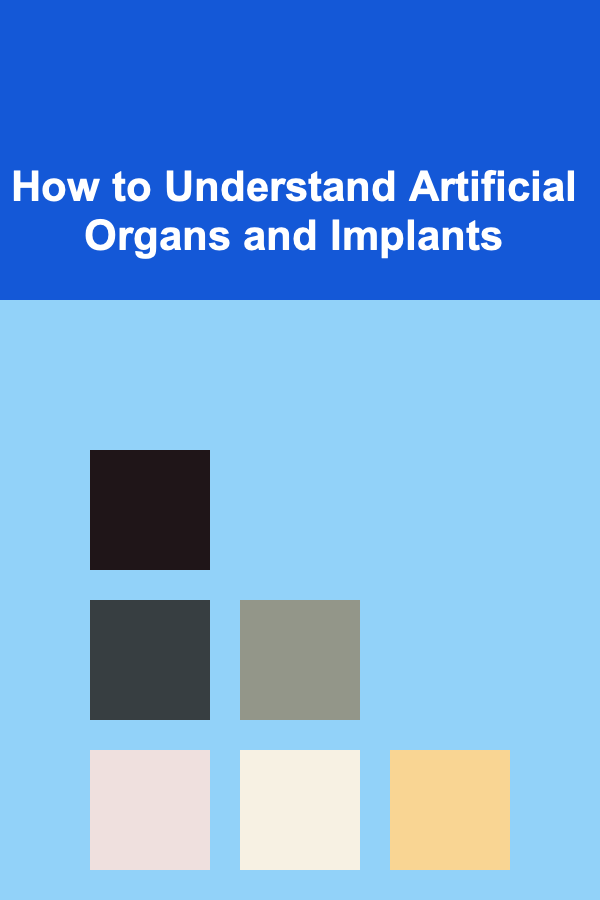
How to Understand Artificial Organs and Implants
ebook include PDF & Audio bundle (Micro Guide)
$12.99$8.99
Limited Time Offer! Order within the next:

The field of artificial organs and implants represents one of the most innovative and transformative areas in modern medicine. Over the past few decades, there has been a monumental leap in medical technology, enabling the development of artificial organs and implants that can replace or enhance the functionality of biological organs and structures. This advancement has opened new possibilities for treating life-threatening diseases and improving the quality of life for countless patients.
Artificial organs and implants are not merely a theoretical concept but practical solutions that are already saving lives, alleviating suffering, and extending the capabilities of medical treatments. To truly understand artificial organs and implants, one must explore their history, development, types, benefits, challenges, and ethical considerations. This article will provide an in-depth exploration of this fascinating subject, aiming to offer a comprehensive understanding.
The Historical Context of Artificial Organs and Implants
The concept of artificial organs dates back centuries, with early thinkers dreaming of replacing lost or damaged body parts. However, the development of these devices is relatively recent, and it is crucial to recognize the historical milestones that have shaped their evolution.
Early Foundations and Precursor Devices
The notion of artificial organs and implants can be traced back to the ancient world. In ancient Egypt, prosthetic limbs were used to replace missing body parts. The most famous example is the "Elderly Egyptian Prosthesis," a wooden and leather prosthetic toe dating back to 1000 BC, which represents the earliest known attempt to replace a body part with an artificial one.
Fast forward to the 19th century, and the field of organ replacement took a significant step forward with the development of early mechanical devices. The invention of the mechanical heart pump in the 1950s by Paul Winchell, a ventriloquist, and Dr. Henry Heimlich, laid the groundwork for future advancements in artificial heart technology.
The Emergence of Modern Artificial Organs
The 20th century witnessed significant progress in artificial organs and implants, primarily driven by medical breakthroughs in biocompatibility, materials science, and bioengineering. One of the major breakthroughs was the development of the dialysis machine in the 1940s, which could replicate the function of kidneys by removing waste products from the blood of patients suffering from kidney failure. The invention of dialysis marked the first major success in organ replacement, providing a lifeline for patients with renal failure.
In the 1950s and 1960s, the development of artificial hearts began to take shape, with the first successful implantation of a mechanical heart in the 1980s. These advancements paved the way for the creation of more complex artificial organs, such as liver , pancreas , lungs , and intestines , as well as implants like pacemakers and neural implants.
Types of Artificial Organs and Implants
Artificial organs and implants can be broadly classified into several categories, each designed to replace or enhance the functionality of a specific biological organ or structure. The key categories include bioartificial organs , mechanical organs , tissue-engineered organs , and implantable medical devices.
1. Bioartificial Organs
Bioartificial organs are devices that combine biological tissues with synthetic materials. These organs are often designed to mimic the structure and function of the natural organ they are replacing. They are typically made by integrating living cells or tissues with biocompatible materials to create an organ-like structure. Some examples of bioartificial organs include:
- Bioartificial Kidney: The development of bioartificial kidneys aims to replicate the functions of a natural kidney by using living renal cells along with a filtration system. These kidneys are currently being tested in clinical trials to treat patients with end-stage kidney failure.
- Bioartificial Liver: This organ uses a combination of human liver cells and a synthetic scaffold to provide a temporary solution for patients with liver failure while awaiting a transplant. The bioartificial liver supports the body's detoxification processes, making it a critical development in organ replacement.
2. Mechanical Organs
Mechanical organs are typically completely synthetic devices designed to replace or support the function of a biological organ. Unlike bioartificial organs, these devices do not rely on living tissues but use advanced engineering and materials to perform vital functions. Some examples include:
- Artificial Heart : The artificial heart is designed to replace a damaged or nonfunctional heart in patients with end-stage heart failure. The most famous example is the Jarvik-7 , which was implanted in the first successful heart transplant patient, Barney Clark, in 1982. Today, ventricular assist devices (VADs) are used as a bridge to heart transplantation or as a long-term solution for patients who cannot undergo a transplant.
- Dialysis Machine: While not an organ in itself, the dialysis machine replicates the kidney's function of filtering blood. It is a life-saving technology for individuals suffering from chronic kidney disease or acute renal failure.
3. Tissue-Engineered Organs
Tissue engineering involves growing human cells into functional tissues that can be used as organs. Unlike bioartificial organs, which combine living cells with synthetic materials, tissue-engineered organs aim to create fully functional organs that are biologically compatible with the human body. Examples include:
- Tissue-Engineered Bladders: Researchers have successfully created functional bladders using the patient's own cells, eliminating the need for a donor organ and minimizing the risk of rejection.
- Liver and Heart Tissue: Advances in tissue engineering are working towards developing complex tissues like liver and heart tissue, with the hope of eventually creating full organs for transplantation.
4. Implantable Medical Devices
Implants are devices that are inserted into the body to support or replace the function of a specific body part. These devices can range from simple, mechanical implants to advanced, electronic implants. Some examples of implantable medical devices include:
- Pacemakers: These small devices are implanted in the chest to regulate the heart's rhythm in patients with arrhythmias or heart failure.
- Cochlear Implants: For patients suffering from severe hearing loss, cochlear implants provide an alternative to hearing aids by directly stimulating the auditory nerve to restore hearing.
- Neuroprosthetics: These implants include brain-machine interfaces and neural stimulators designed to restore lost functions due to spinal cord injuries or neurological disorders. Neuroprosthetics can help individuals regain mobility or control of prosthetic limbs.
Benefits of Artificial Organs and Implants
Artificial organs and implants provide numerous benefits, not only in terms of saving lives but also improving the overall quality of life for patients. These devices address medical conditions that were previously untreatable or highly difficult to manage, offering hope for individuals with terminal illnesses or debilitating conditions.
1. Life-Saving Treatment
The most significant benefit of artificial organs is their ability to save lives. For example, patients with end-stage heart failure can rely on artificial hearts or ventricular assist devices (VADs) to survive until a suitable donor organ becomes available. Similarly, individuals with kidney failure can receive dialysis treatments or even a bioartificial kidney, offering a life-sustaining solution.
2. Enhanced Quality of Life
In addition to life-saving capabilities, artificial organs and implants significantly improve the quality of life for patients. For example, cochlear implants enable individuals with severe hearing loss to regain their ability to hear and communicate, while pacemakers help individuals with arrhythmias lead an active life. These devices reduce symptoms and improve patients' independence, leading to better overall health outcomes.
3. Reduced Risk of Organ Rejection
Tissue-engineered and bioartificial organs are less likely to trigger organ rejection, as they use the patient's own cells or biocompatible materials. This reduces the need for immunosuppressive drugs, which are typically required in organ transplant patients to prevent the body from rejecting the new organ.
Challenges in Artificial Organs and Implants
While the benefits of artificial organs and implants are undeniable, several challenges must be addressed to make these technologies more effective and accessible to patients. These challenges include:
1. Biocompatibility
Biocompatibility remains one of the biggest challenges in the development of artificial organs. Materials must be carefully selected to ensure that they do not cause adverse reactions or trigger immune responses in the body. Research in biomaterials is crucial to improve the biocompatibility of implants and artificial organs.
2. Limited Availability
Though significant progress has been made, many artificial organs, especially bioartificial and tissue-engineered organs, are still in the experimental stages and are not yet widely available. The limited availability of these devices creates a bottleneck, particularly for patients who need urgent replacement organs.
3. Ethical Considerations
The development and use of artificial organs and implants raise numerous ethical questions. These include concerns about access to these life-saving technologies, the potential for exploitation, and the implications of creating organs that are not derived from biological sources. Additionally, there is the ethical dilemma surrounding the long-term effects of implanting devices into the human body and the consequences of reliance on artificial organs.
The Future of Artificial Organs and Implants
The future of artificial organs and implants holds tremendous promise. Advancements in nanotechnology , genetic engineering , and robotics will continue to drive innovation in this field. Researchers are working on creating fully functional, lab-grown organs that can be transplanted into patients, eliminating the need for organ donors.
Additionally, ongoing improvements in biocompatibility, device miniaturization, and the integration of artificial organs with the human nervous system will open new doors for patients with a wide range of medical conditions.
Conclusion
Understanding artificial organs and implants requires an appreciation of both the scientific innovations that make them possible and the profound impact they have on patients' lives. From life-saving devices like artificial hearts and dialysis machines to cutting-edge tissue-engineered organs, the possibilities in this field are vast and transformative. While challenges remain, the future of artificial organs and implants offers a glimpse into a world where medical technology can bridge the gap between natural and artificial, ultimately enhancing and saving lives across the globe.

How to Create a Signature Cocktail for Your Home Party
Read More
How to Host an Eco-Friendly Party at Home
Read More
How to Make Money Online as a Biologist: 10 Actionable Ideas
Read More
How to Make Money Online as an Attorney: 10 Actionable Ideas
Read More
How to Use Cryptocurrency Trading to Make Money
Read More
The Customer Success Manager's Playbook: Essential Tools for Client Success
Read MoreOther Products

How to Create a Signature Cocktail for Your Home Party
Read More
How to Host an Eco-Friendly Party at Home
Read More
How to Make Money Online as a Biologist: 10 Actionable Ideas
Read More
How to Make Money Online as an Attorney: 10 Actionable Ideas
Read More
How to Use Cryptocurrency Trading to Make Money
Read More